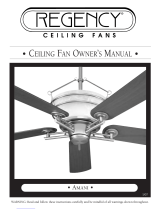OPERATION:
1. Your fan can be operated from the remote control (if installed), giving you three speed choices and full dimming light
control with auto return to the brightness level last set before the light was turned off. (See page 10 for remote control
transmitter operation).
2. If using a wall mounted control instead of the wireless remote control, follow the operation directions supplied with the
wall control. Most are 3-speed with light dimmer.
The slide switch on the top of the fan housing controls forward or reverse rotation. Make sure switch is not stuck between
forward and reverse position.
IMPORTANT: To prevent damage to fan motor when changing direction of rotation, please be sure that fan is off and blades
have stopped moving completely before attempting to change direction.
Periodic cleaning of your new ceiling fan is about the only maintenance that is needed. Only use a soft brush or lint free
cloth to avoid scratching the finish. DO NOT use water when cleaning your ceiling fan. It could damage the motor or the
wood blades, and/or create the possibility of electrical shock.
NOTE: Periodically it may be necessary to re-tighten blade screws to prevent clicking or humming sound during operation.
This is especially true in climates with broad temperature and humidity ranges and in fans with painted or high gloss blades.
NOTE: When dusting the blades, you must support the blade to prevent bending - no pressure should be applied to the blades.
If you experience any flaws in the operation of your fan, please check the following points:
CAUTION: Switch off power supply before carrying out any of these checks.
1. If fan will not start: Check main and branch circuit breakers and/or fuses. Check line wire connections to fan. Make
sure forward/reverse switch is set to one or the other position, not stuck in between.
2. If fan is noisy: Check and make sure that all screws in motor housing are snug (but not over tight). Check that the
screws securing blades to the motor are tight. Check that all glassware is finger tight and that bulb(s) are well held in
the sockets, if a light kit is used. Check that the canopy is firmly attached to hanging bracket and not vibrating against
ceiling.
3. If fan wobbles: Check that all blades are firmly screwed into motor. Check to make sure that light is firmly attached
and that all glassware and shades are fastened properly. Wobble can also result from even the smallest deviations in dis-
tance from blade tip to blade tip - if measurements from blade tip to blade tip are not equal, loosen screws connecting
blade to motor one at a time and adjust blade(s) so that distances are equal. Interchanging adjacent blades may redis-
tribute mass and result in smoother operation.
11
OPERATION
CARE AND CLEANING
TROUBLESHOOTING - INCASE OFDIFFICULTY
www.regencyfan.com 5/04 Regency Ceiling Fans













